
St. Stephen's Episcopal Church is a historic parish of the Episcopal Diocese of Pennsylvania, founded in 1823 in Philadelphia, Pennsylvania and located at 19 South Tenth Street, on the corner of Tenth Street and Ludlow Street. St. Stephen's was designed by William Strickland in the Gothic revival style. It is the oldest extant building in Philadelphia in this style and was designed by an architect-engineer best known for Greek Revival buildings, though, like his mentor Benjamin Latrobe, he produced buildings in other "picturesque" styles as well. St. Stephen's first service was held on February 27, 1823. On June 4, 1979, it was added to the National Register of Historic Places. On May 28, 1957, it was designated a historic landmark by the Philadelphia Historical Commission.

Saint John's Abbey is a Benedictine monastery in Collegeville Township, Minnesota, United States, affiliated with the American-Cassinese Congregation. The abbey was established following the arrival in the area of monks from Saint Vincent Archabbey in Pennsylvania in 1856. Saint John's is one of the largest Benedictine abbeys in the Western Hemisphere, with 110 professed monks. The Right Reverend Fr. John Klassen, OSB, serves as the tenth abbot.

St. James House of Prayer Episcopal Church, also known as the Episcopal House of Prayer, is an active Episcopal parish and historic church building in Tampa, Florida, United States. It is located at 2708 Central Avenue in the city's Tampa Heights neighborhood. On February 21, 1991, the building was added to the U.S. National Register of Historic Places. The structure is also included as an official contributing property within the Tampa Heights Historic District, which was declared a Historic District nationally by the United States Department of the Interior on August 4, 1995, and locally by the city of Tampa on September 7, 2000. Additionally, the building is one of only two churches to have been designated a Local Landmark Structure by the city of Tampa.

The Church of Our Saviour is a historic Carpenter Gothic Episcopal church located at 2979 Coloma Street, in Placerville, El Dorado County, California, in the United States. The church is part of the Episcopal Diocese of Northern California. On November 17, 1977, it was listed in the National Register of Historic Places as the Episcopal Church of Our Saviour.

All Saints Episcopal Church, built in 1872–1873, is an historic Carpenter Gothic church in Saugatuck, Michigan. On February 27, 1984, it was added to the National Register of Historic Places.

Union Episcopal Church, also known as the English Church, is a historic church located on Old Church Road in Claremont, New Hampshire, in the United States. Built in 1773, it is the oldest surviving Episcopal church building in New Hampshire and is also the state's oldest surviving building built exclusively for religious purposes. It is still an active parish in the Episcopal Diocese of New Hampshire. On February 1, 1980, it was added to the National Register of Historic Places.

Christ Church Cathedral is the cathedral for the Episcopal Diocese of Indianapolis. Christ Church parish was formally organized in 1837. The present-day church building was erected in 1857 on Monument Circle at the center of downtown Indianapolis to replace the parish's first church built on the same site. Designed by architect William Tinsley, the English Gothic Revival-style structure is the oldest church building in Indianapolis and Marion County, Indiana, that has remained in continuous use. It is also the oldest building on Monument Circle. Christ Church is known for its music, especially its pipe organs, one of which was donated by Ruth Lilly, and its professional Choir of Men and Boys and Girls' Choir. The parish is also known for its community service, including an annual strawberry festival fundraiser and other charitable work. Christ Church Cathedral was added to the National Register of Historic Places on July 10, 1973. It is located in the Washington Street-Monument Circle Historic District.

The Church of Saint Agnes is a Catholic church of the Archdiocese of Saint Paul and Minneapolis. The parish was founded in 1887 and the current church building was completed in 1912 and listed on the National Register of Historic Places in 1980.

The Church of St. Wenceslaus is a Catholic church in New Prague, Minnesota, United States, constructed in 1907. The church is flanked by a 1908 rectory and a 1914 parochial school, and the three-building complex is listed on the National Register of Historic Places for its association with the Czech American settlement of south-central Minnesota.
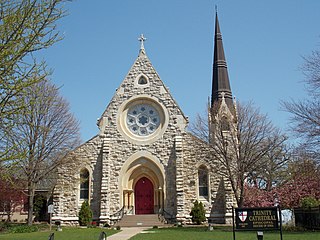
Trinity Episcopal Cathedral, formerly known as Grace Cathedral, is the historic cathedral in the Diocese of Iowa. The cathedral is located on the bluff overlooking Downtown Davenport, Iowa, United States. Completed in 1873, Trinity is one of the oldest cathedrals in the Episcopal Church in the United States. It was individually listed on the National Register of Historic Places in 1974. In 1983 the cathedral was included as a contributing property in the College Square Historic District, which is also listed on the National Register.

Grace Episcopal Church is a historic Episcopal parish at 216 East 6th Street in Hopkinsville, Kentucky, United States. It was built in 1883 and added to the National Register of Historic Places in 1982. The church is a member of the Episcopal Diocese of Kentucky.
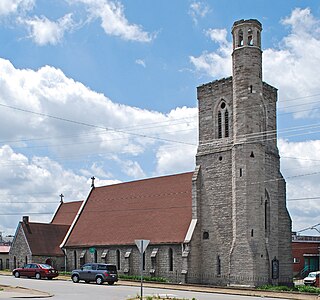
Holy Trinity Church is a historic Episcopal church at 615 6th Avenue South in Nashville, Tennessee, currently a parish of the Episcopal Diocese of Tennessee. The congregation was formed in 1849 as a mission of the nearby Christ Church Episcopal, attained parish status in 1851, and grew to around fifty members per service by the beginning of the American Civil War. During the war, the church was occupied by Federal troops and was badly damaged. After repairs, services continued and a new mission was opened on Wharf Avenue, which catered to the African American population of Nashville and soon overtook Holy Trinity in membership. After Holy Trinity lost parish status in 1895, the two missions merged and continued to serve the African American community of Nashville. Its congregation was largely made up of faculty and students from nearby Fisk University and other educational institutions. The mission reattained parish status in 1962, and the current rector is Bill Dennler.

St. Peter's Episcopal Church is a large historic Carpenter Gothic Episcopal church building located at the corner of Division and Telegraph streets in Carson City, Nevada. Built in 1868, it is the oldest Episcopal church still in use in Nevada. On January 3, 1978, it was listed on the National Register of Historic Places.

The Church of the Good Shepherd built in 1880 is an historic Episcopal church located at 331 Lake Avenue in Maitland, Orange County, Florida. Designed by renowned New York architect Charles C. Haight in the Carpenter Gothic style of architecture, it was built largely through the efforts of the Right Reverend Henry Benjamin Whipple, the first bishop of Minnesota, who began wintering in Maitland in the 1870s. Its board and batten exterior walls and lancet windows are typical of Carpenter Gothic architecture, but its belfry centered over the altar area is unusual. The church was consecrated on March 17, 1883, and Bishop Whipple conducted regular services there each winter for the rest of his life. In 1967, a new modern church designed by Nils M. Schweizer was built to complement the original structure, which since then has served as a chapel. On March 28, 2011, the 1880 church was added to the National Register of Historic Places.
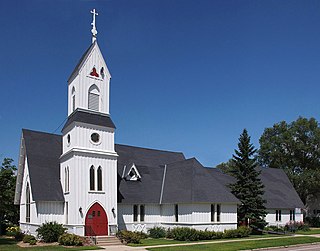
Trinity Episcopal Church is an Episcopal church in Litchfield, Minnesota, United States, built in 1871 in Carpenter Gothic style. It has been attributed to the noted New York architect Richard Upjohn. It was listed on the National Register of Historic Places in 1975 for having local significance in the theme of architecture. It was nominated as a superlative example of Carpenter Gothic design from the mid-19th century.
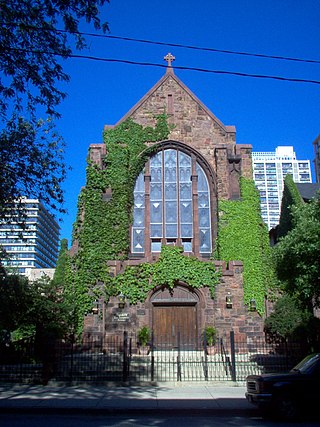
The Episcopal Church of the Atonement and Parish House is a historic church building at 5751 North Kenmore Avenue in Chicago, Illinois. The Gothic Revival building was constructed in 1889 and added to the National Register of Historic Places in 2009.
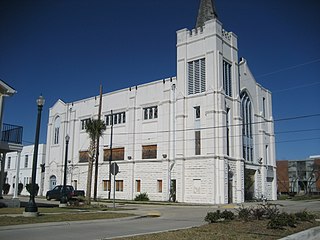
The Union Bethel A.M.E. Church in New Orleans, Louisiana, at 2321 Thalia St. at the corner of Liberty St., is a historic African Methodist Episcopal church.
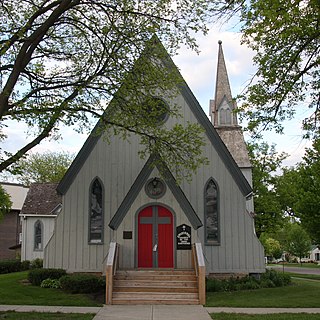
Church of the Good Shepherd Episcopal, a notable example of Rural Gothic architecture located at Moore and 8th Streets in Blue Earth, Minnesota, is the oldest surviving church building in the community. As the congregation diminished in the 1970s regular worship services were eventually suspended; in 1981 its three remaining members donated the building to the Faribault County Historical Society. Since then the church has hosted seasonal ecumenical services, Christmas concerts, weddings, and funerals. It was added to the National Register in 1980.

The Grace Memorial Episcopal Church is a historic church in Wabasha, Minnesota, United States, built in 1900. The building was listed on the National Register of Historic Places in 1982 for having local significance in the themes of architecture and religion. It was nominated for being "the most distinguished ecclesiastical structure" in Wabasha and "the work of prominent Minnesota architect Cass Gilbert".

Harris Hall is an auditorium located at 617 East Huron Street in Ann Arbor, Michigan. It was listed on the National Register of Historic Places in 1982.






















